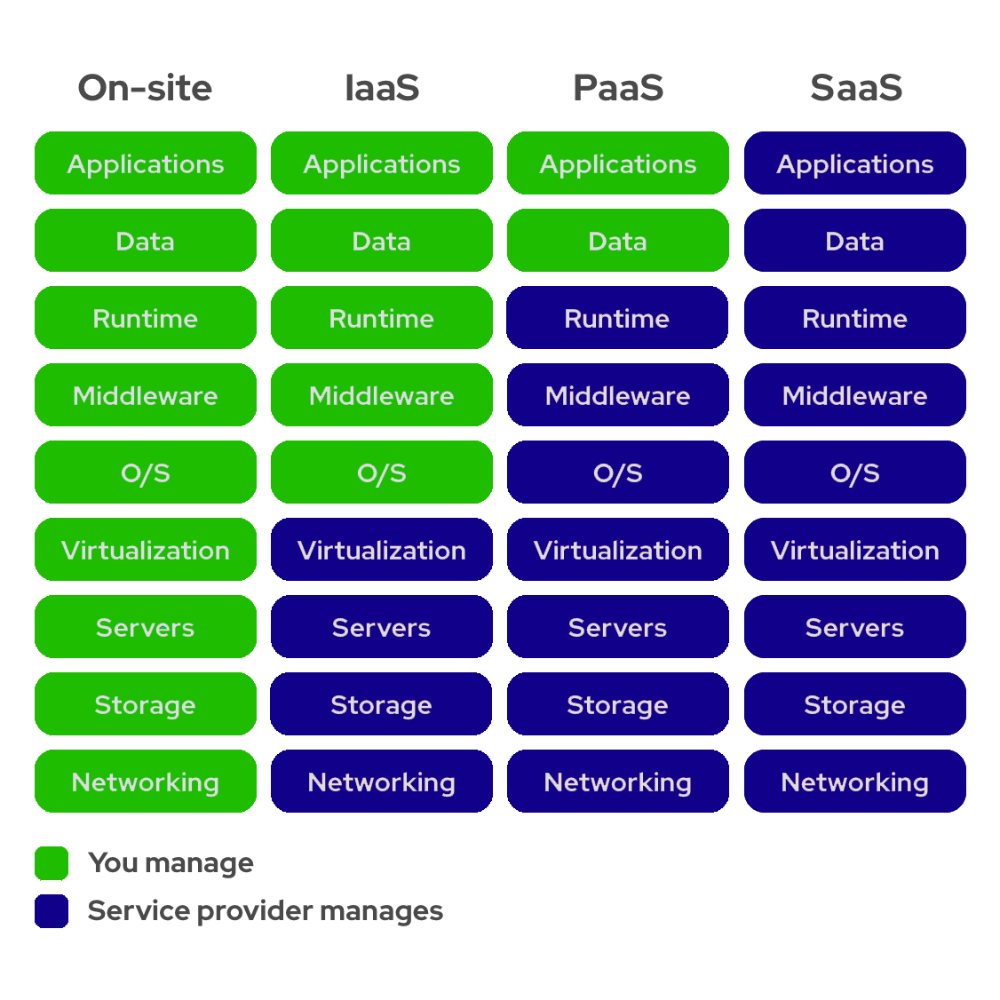Cloud computing has become an essential part of modern-day business operations, offering a flexible and scalable solution for managing computing resources. Among the various cloud computing models, Software as a Service (SaaS), Platform as a Service (PaaS), and Infrastructure as a Service (IaaS) are the most popular. These models provide businesses with varying levels of control, flexibility, and cost-effectiveness, depending on their specific needs. In this blog post, we will explore the (SaaS vs PaaS vs IaaS)differences between SaaS, PaaS, and IaaS, their benefits, use cases, and how to choose the right cloud computing solution for your business.
Key Difference – SaaS vs PaaS vs IaaS
SaaS, PaaS, and IaaS are the three main cloud computing service models. The key difference between them is the level of control and responsibility that the user has over the application, platform, and infrastructure.

What is SaaS? – Software as a Service
Software as a Service (SaaS) is a cloud computing model that provides users with access to software applications over the internet. SaaS eliminates the need for users to install or maintain the software locally, as the software is hosted and managed by a third-party provider. SaaS applications can be accessed from anywhere with an internet connection, making them highly flexible and convenient. Users typically pay a monthly or annual subscription fee for the software, and the provider takes care of updates, maintenance, and security.
Benefits of Software as a Service (SaaS):
Here are the benefits of SaaS (Software as a Service)
- Easy accessibility from anywhere with an internet connection
- Cost-effectiveness by eliminating the need for businesses to maintain software on their own hardware
- Automatic updates ensure that users always have access to the latest features and security patches
- High scalability allows businesses to quickly and easily add or remove users and features as their needs change
- Reduced hardware and maintenance costs
- Increased mobility and productivity
Overall, SaaS provides a cost-effective and flexible solution for companies looking to streamline their software management and focus on their core business functions.
Limitations of SaaS:
- Dependence on internet connectivity can result in slower performance and potential downtime
- Limited customization options and integration with existing systems may not meet all business needs
- Data security concerns as data is stored on third-party servers
- Limited control over software updates, which can cause compatibility issues or functional changes that affect business operations
- Potential unexpected costs due to exceeding usage limits or SaaS provider increasing subscription fees
- Potential loss of data if the SaaS provider goes out of business or experiences technical difficulties
Use Cases for SaaS:
Here are some use cases for SaaS (Software as a Service)
- Customer relationship management (CRM)
- Human resources management (HRM)
- Email marketing
- Accounting and finance management
- Enterprise resource planning (ERP)
- Project management
- Supply chain management
- E-commerce
- Video conferencing and collaboration tools
SaaS solutions are commonly used by businesses of all sizes to streamline their operations, improve efficiency, and reduce costs.
Popular Examples of SaaS:
- Google Workspace (formerly G Suite)
- Salesforce
- Dropbox
- Zoom
- Slack
- Hubspot
- Canva
- Mailchimp
- Shopify
- Microsoft 365 (formerly Office 365)
Check out newly launch SaaS products at BufferApps Sites for better understanding. It is the perfect platform for entrepreneurs to find the best software/app for their business.

What is PaaS? – Platform as a Service
Platform as a Service (PaaS) is a cloud computing model that provides a platform for developing, testing, and deploying software applications over the internet. PaaS provides developers with a complete environment to build and run their applications, without having to manage the underlying infrastructure. It offers a high degree of flexibility, scalability, and cost-effectiveness, allowing businesses to focus on their application development rather than managing infrastructure. PaaS providers typically offer a range of development tools, databases, middleware, and other resources to help developers build and deploy their applications.
Benefits of PaaS:
Here are the benefits of Platform as a Service (PaaS)
- Complete development environment provided to build and run software applications
- No need to manage the underlying infrastructure, allowing businesses to focus on application development
- Flexibility, scalability, and cost-effectiveness in deploying applications quickly and easily
- Wide range of development tools, databases, middleware, and other resources available to developers
- Reduced time-to-market for applications
- Increased collaboration and efficiency between development teams
Overall, PaaS offers a cost-effective and efficient solution for businesses looking to stay ahead of the competition by delivering cutting-edge applications to their customers.
Limitations of PaaS:
- Limited control over the underlying infrastructure, which can lead to vendor lock-in and potential performance issues
- Limited customization options, as the platform is pre-configured and designed to support a specific programming language or framework
- Potential limitations on scalability due to resource allocation constraints by the PaaS provider
- Dependency on the PaaS provider for software updates and security patches, which can result in downtime and compatibility issues
- Data security concerns, as the PaaS provider has access to application and user data stored on their platform
- Potential loss of data if the PaaS provider goes out of business or experiences technical difficulties.
PaaS Use Case:
PaaS (Platform as a Service) can be used to build, deploy, and manage applications in the cloud. Its use cases include:
- Developing and deploying web applications
- Creating and managing software development environments
- Developing and deploying mobile applications
- Developing and deploying IoT (Internet of Things) applications
- Creating and managing databases
- Building and deploying machine learning models
Popular Examples of PaaS:
- AWS Elastic Beanstalk
- Google App Engine
- Microsoft Azure App Service
- Heroku
- IBM Cloud Foundry
- Oracle Cloud Platform
- Mendix
- OpenShift by Red Hat
- Pivotal Cloud Foundry
- Salesforce Heroku
What is IaaS? – Infrastructure as a Service
Infrastructure as a Service (IaaS) is a cloud computing model that provides computing infrastructure, including servers, storage, and networking resources, over the Internet. IaaS allows users to rent computing resources and pay only for what they use, instead of having to maintain and manage the infrastructure themselves. It offers a high degree of flexibility, scalability, and cost-effectiveness, making it an ideal choice for businesses that need to quickly scale their computing resources up or down. IaaS providers typically offer a range of computing resources, including virtual machines, storage, and networking, which can be accessed and managed via a web-based dashboard or API (Application Programming Interface).
Benefits of IaaS:
Here are the benefits of Infrastructure as a Service (IaaS)
- Cost-effective alternative to traditional on-premises infrastructure, reducing hardware and maintenance costs
- Highly scalable, allowing businesses to quickly and easily add or remove computing resources as their needs change
- Access to a wide range of computing resources, including virtual machines, storage, and networking
- No need to manage or maintain physical infrastructure, allowing businesses to focus on their core operations
- Flexibility to choose the operating system, programming language, and other software tools to meet specific business needs
- Increased reliability and disaster recovery, with automatic backup and replication options available from IaaS providers
Overall, IaaS Provides flexibility to run various applications and operating systems, allowing businesses to customize their IT infrastructure to suit their specific needs.
Limitations of IaaS:
- Requires in-house expertise to manage and maintain the infrastructure
- Limited control over the underlying hardware, as the provider maintains the physical servers
- Resource allocation constraints can limit scalability and performance
- Dependency on the provider for security and software updates, which can lead to downtime and compatibility issues
- Potential security concerns due to shared infrastructure and access to data by the IaaS provider
- Potential unexpected costs due to exceeding usage limits or the provider increasing subscription fees
- May not be suitable for all workloads, as certain applications or systems may require specialized hardware or software not available on the IaaS platform.
IaaS Use Case:
- Web hosting and website infrastructure
- Storage, backup, and recovery solutions
- Virtual desktop infrastructure (VDI)
- Test and development environments
- Big data processing and analysis
- High-performance computing (HPC)
- Disaster recovery and business continuity solutions
- Internet of Things (IoT) platforms
- Machine learning and artificial intelligence (AI) infrastructure
Popular Examples of IaaS:
- Amazon Web Services (AWS) EC2
- Microsoft Azure VMs
- Google Cloud Compute Engine
- DigitalOcean
- IBM Cloud Virtual Servers
- Oracle Cloud Infrastructure Compute
- Rackspace Cloud
- Linode
- Vultr
- Kamatera
Conclusion: SaaS vs PaaS vs IaaS
The choice between SaaS, PaaS, and IaaS ultimately depends on the specific needs and goals of your organization. While SaaS provides pre-built software applications that can be accessed through the Internet, PaaS offers a platform for building and deploying custom applications, and IaaS provides a virtualized infrastructure with complete control over hardware and software. Understanding the differences and benefits of each cloud model is crucial in determining which one is the best fit for your business. Whether you need to streamline your software applications, build custom software, or have complete control over your infrastructure, moving to the cloud is the future of business and technology.
FAQs- SaaS vs PaaS vs IaaS
What is the difference between SaaS, PaaS, and IaaS (SaaS vs PaaS vs IaaS)?
SaaS (Software as a Service) is a software delivery model where a provider hosts applications and makes them available to customers over the Internet. PaaS (Platform as a Service) is a cloud computing model where a provider delivers a platform to customers, allowing them to develop, run, and manage applications without the complexity of building and maintaining the infrastructure. IaaS (Infrastructure as a Service) is a cloud computing model where a provider offers virtualized computing resources over the Internet.
Which cloud service model is best for my business: SaaS, PaaS or IaaS?
The best cloud service model for your business depends on your specific needs and goals. SaaS is ideal for businesses that want to quickly deploy and use software without having to worry about infrastructure or maintenance. PaaS is ideal for businesses that want to develop and deploy custom applications without having to manage the underlying infrastructure. IaaS is ideal for businesses that need more control over their infrastructure and want to build their own custom solutions.
How do I choose between SaaS, PaaS, and IaaS?
When choosing between SaaS, PaaS, and IaaS, it’s important to consider your business needs and goals. Consider factors such as cost, scalability, flexibility, control over infrastructure, and ease of use when making your decision.
What is the difference between IaaS and PaaS (IaaS vs PaaS)?
IaaS (Infrastructure as a Service) provides the foundational infrastructure such as servers, storage, and networking while PaaS (Platform as a Service) builds on top of IaaS by providing a platform for developers to build, test, and deploy their applications without having to manage the underlying infrastructure.
What is the difference between PaaS and SaaS (PaaS vs SaaS)?
PaaS provides a platform for developers to build, test, and deploy their own applications, while SaaS provides pre-built software applications that are hosted in the cloud and accessed through a web browser.

